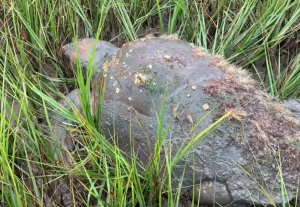The team, led by Ravin Grove, an assistant crew leader for the Cape Romain “Turtle Team,” included Kristen Mae Carpenter, environmental education coordinator, and Alicia Robino, the environmental education intern, with Friends of Coastal South Carolina.

“Sea turtles only come on land when they’re first born and when the females come up to lay eggs,” Robino said. “They get exhausted easily on land. Once they hit the water, they’re actually pretty graceful.”

“She crawled on the beach for a long time. Her tracks were all over, in circles and loops. She may have only been in the marsh for a little while by the time we got there,” Robino said. “If she had been left there she probably would have died of exposure there.”

Grove, Carpenter and Robino used towels and water to keep her from drying out as they moved her toward the ocean until she could continue on her own.
The turtle didn’t make a nest or lay eggs during her visit to the beach.
The Turtle Team patrols the beaches of Cape Romain every day from May through October, rain or shine, looking for nests by following turtle crawls.
Last year there were 3,596 nests on the Cape Romain National Wildlife Refuge. As of Sunday, they’d found 858 this season. Nesting season is May through August.
Loggerhead sea turtles are South Carolina’s state reptile. They are endangered.

If you find a stranded sea turtle, do not attempt to touch or help it. Instead, you should call the South Carolina Dept. of Natural Resources stranding hotline at 1-800-922-5431 or a local sea turtle patrol.
You can support Cape Romain by donating to Friends of Coastal South Carolina, and Coastal Expeditions on their respective websites.
U.S. Fish and Wildlife facilitates the work and is responsible for the maintenance of the refuge.